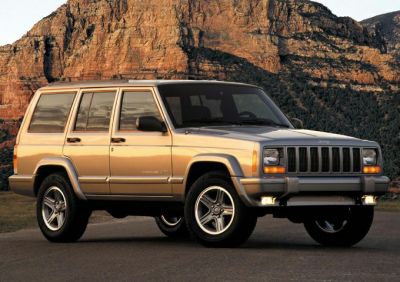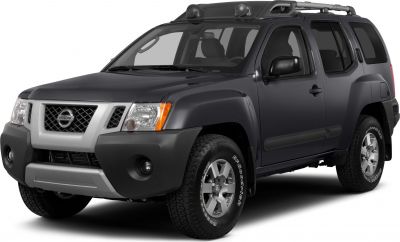 2005 Nissan Xterra II Dimensions, Size & Specs
2005 Nissan Xterra II Dimensions, Size & SpecsMeasurements of the 2005 Nissan Xterra II, engineered for optimal performance and comfort
| Dimensions | |
|---|---|
| Length: | 4539 mm178.7 in14.9 ft |
| Width: | 1849 mm72.8 in6.1 ft |
| Height: | 1902 mm74.9 in6.2 ft |
| Ground Clearance: | 211 mm8.3 in0.7 ft |
| Trunk Capacity: | 997 liter35.2 cu ft |
| Trunk Capacity (Max): | 1860 liter65.7 cu ft |
| Weight Specifications | |
| Curb Weight: | 1882-1985 kg4149-4376 lbs |
| Tire Specifications | |
| Tire Sizes: |
|
The Nissan Xterra II, produced from 2005 to 2008, is a robust mid-size SUV designed for versatile off-road and everyday use. This second-generation Xterra offers a commanding presence with a length of 4539 mm (178.7 inches), a width of 1849 mm (72.8 inches), and a height of 1902 mm (74.9 inches), providing a spacious and comfortable cabin environment. The vehicle's curb weight ranges between 1882 kg and 1985 kg (4149 to 4374 lbs), reflecting its solid build suited for rugged terrains and family adventures.
One of the standout features of the Xterra II is its generous cargo capacity. With the rear seats in an upright position, the luggage space offers up to 997 liters (35.2 cubic feet), which expands significantly to 1860 liters (65.6 cubic feet) when the rear seats are folded down. This flexibility makes it ideal for carrying camping gear, sports equipment, or larger loads, enhancing its utility for outdoor enthusiasts and practical daily use alike.
The Nissan Xterra II also boasts a ground clearance of 211 mm (8.3 inches), allowing the SUV to tackle uneven and challenging off-road surfaces with ease. It comes equipped with sturdy tire options, including 265/75 R16 and 265/65 R17 sizes, delivering enhanced grip and stability across diverse driving conditions.
Overall, the 2005-2008 Nissan Xterra II is a well-rounded SUV that combines impressive dimensions, practical cargo space, and capable off-road features, making it an excellent choice for drivers seeking durability, space, and versatility in a mid-size sport utility vehicle.
Discover the standout features that make the 2005 Nissan Xterra II a leader in its class
Have a question? Please check our knowledgebase first.
The Nissan Xterra II, produced from 2005 to 2008, measures 4539 mm (178.6 inches) in length, 1849 mm (72.8 inches) in width, and 1902 mm (74.8 inches) in height. These dimensions place it firmly in the mid-size SUV category, offering a balanced footprint suitable for both urban and off-road driving conditions.
The curb weight of the Nissan Xterra II ranges between 1882 kg and 1985 kg (approximately 4149 to 4375 lbs). This weight, typical for SUVs in its class, provides a sturdy and stable driving experience. However, the relatively higher mass can impact fuel economy, generally leading to moderate consumption typical for mid-size SUVs, while contributing to improved road presence and off-road capability.
The Nissan Xterra II offers a ground clearance of 211 mm (8.3 inches), which is quite respectable for an SUV. This elevated ride height allows the vehicle to navigate over rough terrain, rocks, and uneven surfaces with confidence, making it well-suited for off-road adventures without risking damage to the undercarriage.
With the rear seats in their upright position, the Nissan Xterra II offers a luggage capacity of 997 liters (35.2 cubic feet), providing ample cargo space for groceries, sports gear, or travel bags. When the rear seats are folded down, this capacity expands significantly to 1860 liters (65.7 cubic feet), allowing for larger items and increased versatility for hauling larger loads or camping equipment.
The Nissan Xterra II is equipped with tire sizes 265/75 R16 or 265/65 R17, depending on the model and trim. These substantial tires provide a good balance between off-road traction and on-road comfort. The larger contact patch enhances grip on various surfaces, while the sidewall height offers a cushioning effect over rough terrain, contributing to a smoother ride.
With a length of 4539 mm (178.6 inches), width of 1849 mm (72.8 inches), and height of 1902 mm (74.8 inches), the Nissan Xterra II fits comfortably inside most standard residential garages. However, clearance may be tight in garages with lower ceilings or smaller widths. Before parking, it's advisable to measure your garage space to ensure sufficient room for opening doors and maneuvering.
Compared to the first-generation Xterra (1999–2004), the second-generation model (2005-2008) is slightly larger and more refined. The Xterra II is longer and wider, contributing to increased interior space and cargo capacity. It also features a higher roofline for better headroom. These dimensional improvements enhance passenger comfort and versatility, while maintaining the rugged character that defined the original.
The Nissan Xterra II competes well against midsize SUVs like the Toyota 4Runner, Jeep Grand Cherokee, and Ford Explorer from the mid-2000s. It offers competitive length and width, with a slightly taller height that favors interior space. Its ground clearance of 211 mm (8.3 inches) is on par or better than many rivals, making it more capable off-road. Cargo volumes are similarly spacious with 997 liters rear seats up and 1860 liters folded, placing the Xterra II among the versatile and practical models in its class.
The Nissan Xterra II combines rugged SUV styling with practical design elements geared towards outdoor enthusiasts. It features a sturdy body-on-frame construction, high ground clearance of 211 mm (8.3 inches), and large tires (265/75 R16 or 265/65 R17) that enhance off-road capability. Inside, it offers versatile cargo space with almost 1,000 liters available behind the rear seats, expanding to 1,860 liters with seats folded. The design focuses on durability, utility, and driver comfort, making it a favored choice for adventurers and families alike.
The Nissan Xterra II weighs between 1882 kg and 1985 kg (4149 to 4375 lbs), which gives it a solid presence on the road. This weight contributes to stability and a reassuring driving feel, especially at highway speeds and off-road conditions. However, the relatively heavy mass may affect acceleration and fuel efficiency, requiring some adjustment in driving style for optimal performance and fuel economy.
Discover similar sized cars.

| Production: | 2001-2008 |
|---|---|
| Model Year: | 2002 |
| Length: | 4430-4496 mm174.4-177.0 in |
| Width: | 1820 mm71.7 in |
| Height: | 1866 mm73.5 in |

| Production: | 2008-2015 |
|---|---|
| Model Year: | 2009 |
| Length: | 4539 mm178.7 in |
| Width: | 1849 mm72.8 in |
| Height: | 1902 mm74.9 in |
